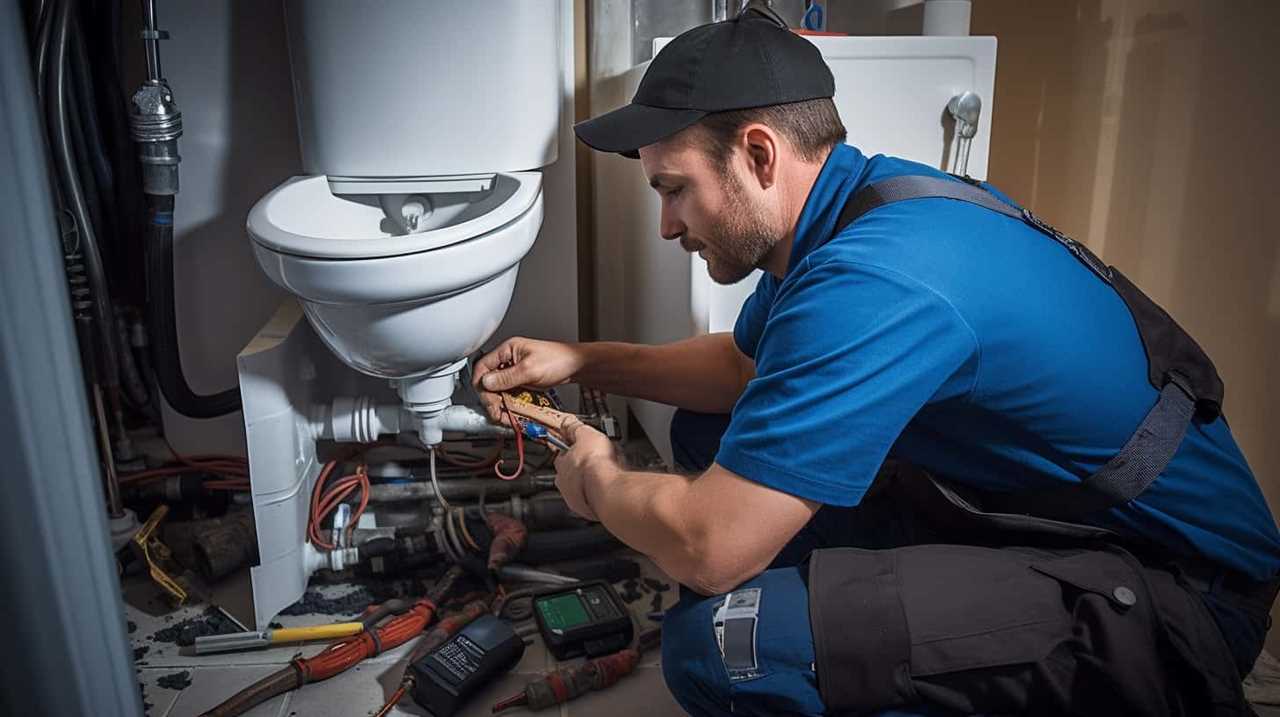Dear ladies and gentlemen, have you ever pondered why our cherished toilet bowls sometimes do not flush properly? Have no fear, as we are here to uncover the reasons behind this common issue.
From inadequate water levels to clogged drains, faulty flappers to malfunctioning flush valves, we shall explore the myriad reasons behind this frustrating phenomenon.
Prepare to dive into the technical realm of toilets and acquire the mastery of understanding why they don’t flush all the way.
Key Takeaways
- Inadequate water level in the tank can result in a weak flush, and checking and adjusting the float mechanism can fix this issue.
- Clogged drains can be caused by debris accumulation, flushing foreign objects, tree root infiltration, or mineral deposits from hard water. Clearing the drain requires employing drain cleaning techniques.
- A faulty flapper can cause water leakage and an incomplete flush, and it may need to be replaced.
- A malfunctioning flush valve can result in an incomplete flush, and checking for debris or mineral buildup and adjusting the chain connecting the flush handle can resolve some issues. Regular toilet maintenance helps prevent future flushing issues.
Inadequate Water Level
One reason why toilets may not flush all the way is because the water level is inadequate. The water level in the toilet tank plays a crucial role in ensuring a proper flush. When the water level is too low, there may not be enough force to push waste through the pipes effectively.

The water level in the tank is regulated by a float mechanism. This mechanism is responsible for controlling the inflow of water into the tank. If the float mechanism isn’t functioning properly, it may not allow enough water to enter the tank, resulting in an inadequate water level.
To fix this issue, it’s important to check and adjust the float mechanism to ensure it’s allowing the tank to fill to the correct water level.
Clogged Drain
Our first step in troubleshooting a clogged drain is to check for any blockages in the toilet pipes. To effectively address this issue, we need to employ drain cleaning techniques.
Here are some common causes of clogged drains:

- Accumulation of debris: Hair, soap scum, and other particles can build up in the drain over time and obstruct the flow of water.
- Foreign objects: Items like toilet paper, cotton balls, or sanitary products can cause blockages if flushed down the toilet.
- Tree roots: Roots from nearby trees can infiltrate the drain pipes, causing blockages and damage.
- Mineral deposits: Hard water can lead to the accumulation of mineral deposits in the pipes, restricting the flow of water.
By understanding these causes, we can take appropriate action to clear the clogged drain and ensure proper functioning.
Now let’s move on to the next section and explore the topic of the faulty flapper.
Faulty Flapper
To continue addressing the issue of a toilet that doesn’t flush all the way, let’s now delve into the topic of a faulty flapper. The flapper is a small rubber valve located at the bottom of the toilet tank. Its main function is to control the flow of water from the tank into the bowl during a flush. When the flapper becomes faulty, it can lead to water leakage and an incomplete flush.
To fix this problem, flapper replacement is necessary. This involves shutting off the water supply to the toilet, removing the old flapper, and installing a new one. The table below illustrates the steps involved in replacing a faulty flapper:

| Steps for Flapper Replacement |
|---|
| 1. Shut off water supply to toilet |
| 2. Drain the toilet tank |
| 3. Remove the old flapper |
| 4. Install the new flapper |
Malfunctioning Flush Valve
Sometimes, we experience a malfunctioning flush valve that can cause a toilet to not flush all the way. When this happens, it’s important to address the issue promptly to ensure proper toilet functionality.
Here are some troubleshooting tips for dealing with a malfunctioning flush valve:
- Check for debris: Remove the tank lid and inspect the flush valve for any debris or mineral buildup. Clean it thoroughly using a soft brush or cloth.
- Adjust the chain: The chain connecting the flush handle to the flush valve can sometimes be too loose or too tight. Adjust it to ensure proper operation.
- Replace the flush valve: If the flush valve is damaged or worn out, it may need to be replaced. Consult a professional or follow manufacturer instructions for proper installation.
- Regular toilet maintenance: Perform regular toilet maintenance, including cleaning the flush valve and other components, to prevent future issues with flushing.
Insufficient Water Pressure
To address the issue of insufficient water pressure, we need to understand its impact on the flushing capability of a toilet.
Low water flow caused by plumbing issues can result in a weak and ineffective flush. When the water pressure is inadequate, the force needed to clear waste from the toilet bowl is compromised.

Insufficient pressure can prevent the toilet from effectively pushing waste through the drain pipe and into the sewer system. This can lead to clogs and backups, creating a frustrating and unsanitary situation.
To resolve this issue, it’s important to identify and address any plumbing problems that may be causing low water flow. This can involve inspecting and repairing any leaks, blockages, or faulty components in the plumbing system.
Frequently Asked Questions
How Can I Fix a Toilet That Doesn’t Flush Properly Due to an Inadequate Water Level?
To increase the water level in a toilet and troubleshoot low water level, we can adjust the float arm or valve, remove any blockages, or replace the fill valve if necessary.
What Are Some Common Signs of a Clogged Drain Causing Poor Toilet Flushing?
Common signs of a clogged drain causing poor toilet flushing include slow drainage, gurgling sounds, and water backup in other fixtures. To maintain a healthy flush, try using common solutions like plunging or using a drain snake.

Can a Faulty Flapper Cause a Toilet Not to Flush All the Way, and if So, How Can I Troubleshoot and Fix This Issue?
A faulty flapper can cause a toilet to not flush all the way. To troubleshoot, check if the flapper is properly sealing the tank. If not, adjust or replace the flapper to fix the issue.
What Are the Possible Reasons Behind a Malfunctioning Flush Valve and How Can I Address This Problem?
When troubleshooting a faulty flush valve, we explore potential causes and solutions. By examining the possible reasons for malfunctioning and implementing troubleshooting tips, we can effectively address this issue and restore optimal flushing functionality.
Is Insufficient Water Pressure a Common Cause of Toilets Not Flushing Properly, and Are There Any DIY Solutions to Improve Water Pressure in the Toilet?
Insufficient water pressure in toilets can cause flushing issues. DIY methods to improve toilet water pressure include checking the water supply valve, cleaning the fill valve, and adjusting the float. Troubleshooting low water pressure is crucial for optimal flushing.
Conclusion
In conclusion, the reasons for a toilet not flushing all the way can vary from inadequate water levels and clogged drains to faulty flappers and malfunctioning flush valves.

Additionally, insufficient water pressure can also contribute to this issue.
By addressing these potential problems, homeowners can ensure their toilets function properly and avoid any inconvenient situations.
Maintaining a functional and efficient toilet system is essential for a clean and hygienic bathroom experience.










